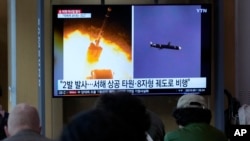North Korea has launched a series of provocations within 24 hours in a continuing offensive posture, including another ballistic missile test, a dispatch of military planes, and the firing of hundreds of rounds of artillery along both coasts of the Korean Peninsula.
South Korea’s Joint Chiefs of Staff (JCS) said Friday night it detected some 390 rounds of artillery fire along the west and east coasts from 5 p.m. to 7 p.m. local time. Along the west coast, there were about 300 rounds of artillery fire from North Korea’s Haeju Bay to Jangsagot, the JCS said, while 90 rounds were heard from Jangjon, Gangwon Province, into the East Sea.
Some 130 fishing boats were brought back to land from northwestern waters as a precautionary measure, the Korea Coast Guard said.
The artillery landed in maritime buffer zones of both sides of the peninsula, according to the JCS, in violation of a tension-reducing pact, the Comprehensive Military Agreement (CMA), signed in September of 2018 by the two Koreas. The CMA has been under scrutiny in South Korea because of growing belligerence from North Korea. South Korean President Yoon Suk Yeol Friday said the fate of the inter-Korean military pact would be determined by North Korea's next steps.
The late afternoon violations appear to be a retaliation for a warning sent earlier in the day by Seoul’s Defense Ministry via a military communication line, condemning pre-dawn artillery firings as a violation of the CMA and urging North Korea to keep to the pact.
South Korea’s National Security Council (NSC) “strongly condemned” the North’s military acts in the early hours of the day, including a short-range ballistic missile launch it said was in violation of multiple United Nations Security Council resolutions. It reiterated Seoul's commitment to show Pyongyang that there would be consequences to provocations.
The NSC also called on U.N. Security Council member states to fulfill their duties responsibly, in a nod to China and Russia's defense of North Korea in last week's UNSC meeting called after Pyongyang fired an intermediate range missile over Japan for the first time since 2017.
The U.S. State Department, in a statement to VOA Korean, said it continues to “seek serious and sustained dialogue” with North Korea, adding that Washington’s commitment to South Korea and Japan’s defense remained “ironclad.”
From Japan, Chief Cabinet Secretary Hirokazu Matsuno on Friday called North Korea’s repeated ballistic missile launches “absolutely unacceptable” and said it was “becoming increasingly difficult to identify and counter [them] at an early stage.”
China maintained its position, despite Pyongyang's continuing ballistic missile test with less than two days to go to its Communist Party Congress.
Its foreign ministry spokesperson, Mao Ning, advised against escalating tensions and called on relevant parties to resume meaningful dialogue toward a political solution.
All-night provocation
North Korea’s latest string of military activity began between 10:30 p.m. Thursday and 12:30 a.m. Friday local time, according to the JCS. South Korea scrambled fighter jets, including F-35s, when some 10 North Korean military planes flew within 5 kilometers of a no-fly zone previously agreed upon between the two Koreas — the closest they had gotten in the past weeks of tension-raising exercises.
About an hour after, it sent 130 artillery shells into the Yellow Sea to the west of the Korean Peninsula from the North’s Hwanghae Province, the JCS said.
A short-range ballistic missile was fired at about 1:49 a.m. from the Sunan area in Pyongyang to the East Sea, flying some 700 kilometers at a top altitude of 50 kilometers, the JCS said.
In the continuing early morning hours, it fired 40 artillery rounds eastward from Gueup-ri in the Gangwon Province. Both early morning rounds of artillery fire landed within maritime buffer zones on either side of the peninsula, in violation of the inter-Korean military pact.
A swift statement by the North Korean military’s general staff was issued via the Korean Central News Agency, explaining the brazen acts as “strong military countermeasures” against the South Korean army’s “reckless” artillery fire that lasted for “about 10 hours” on Thursday in “the frontline area.”
More drills ahead
The said weapons fire referred to a U.S. Forces Korea artillery exercise at a firing range in Cheorwon, Gangwon Province, according to Seoul-based Yonhap News, citing officials, from 8 a.m. through 6 p.m. Thursday.
Seoul’s JCS has said it will continue reviving joint military exercises with the U.S., including live field training starting next Monday, as it forges an airtight readiness against future provocations from the North, as well as strengthens the U.S.-South Korea alliance.
The "Hoguk Exercise" — which involves the air force, army and navy — will be conducted for two weeks, practicing various threat scenarios involving North Korean missiles and nuclear weapons.








